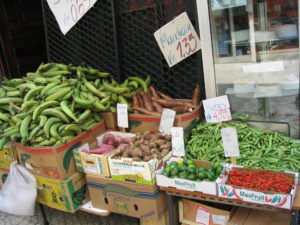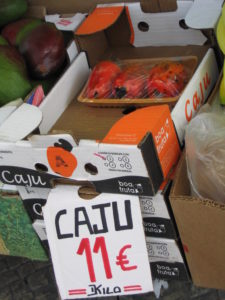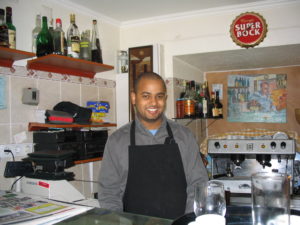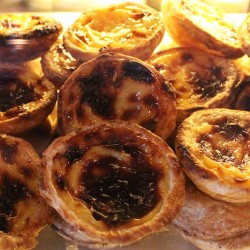
Peri-Peri peppers at bottom right of produce display in front of a market in Lisbon.
Peri-peri. The evocative Portuguese word fascinated me, even before I had discovered much about it. It was quite possible I heard it during the year I was teaching refugees from the colonial countries of southern Africa in Dar es Salaam, Tanzania. I associated it with Mozambique and Angola, two countries whose students I taught. The word, which the Portuguese borrowed, meant “pepper-pepper” in Swahili. It denoted a spicy chicken or shrimp barbecue, as well as the chili-based sauce in which it was marinated. Even after traveling on a ship that docked in Beira and Lourenço Marques, two Mozambican cities, where peri-peri reigned, I left without sampling the dish.
My courtship with Portuguese food was a tentative one. I associated it with traditional items, like chorizo, a spicy cured sausage, and seafood plates and stews, not with blazing spice. I remember trying a bland bacalhau dish, a cod and potato casserole, in an East Providence, Rhode Island Portuguese restaurant, and not being won over.
Roaming Portuguese enclaves in the U.S., I searched for the dish. I explored eateries in New Bedford, Massachusetts, the old Portuguese fishing port. In a Portuguese pocket of Hartford, Connecticut, I stumbled in pronouncing peri-peri and was courteously corrected by the waitress, who pronounced it “peedee peedee.” I hunted for peri-peri in the Ironbound section of Newark, the nation’s second largest Portuguese community. In one eatery, I was offered what seemed like a facsimile of the specialty, not the genuine article. I pressed the waiter for more information about my quarry, but, aside from a colorful account of the young migrant’s background, I came up empty.

Cashew fruits for sale at market in Lisbon.
A trip to Portugal opened up new vistas on peri-peri and on the cuisine of this Iberian nation. I was transfixed by displays of the food that reflected a mariner culture conversant with exotic goods. In front of a grocery a short distance from the Rossio, the square that is the crossroads of the Portuguese capital, I saw tiny red peri-peri chili peppers sharing a box with fresh, inviting ginger roots. Long, snaky brown-skinned manioc root (or cassava), a starchy vegetable used by both Brazilians and West Africans, was another striking sight on this Lisbon sidewalk. I also noticed a box of plastic-wrapped caju fruits, resembling red bell peppers, from the base of which the cashew nut grows. The Indians in Brazil, who made wine from the caju, taught the Portuguese about this unusual fruit. The Portuguese transplanted it to Goa, their colony in southwest India, where it became the largest cash crop. Both the cashew nut and feni, a potent drink made from the fruit, gained an enthusiastic following in Goa.
Inside the shop were bottles of caju concentrate, which could be used to make both alcoholic and non-alcoholic refreshments. Shelves were stocked with palm oil, an orange-ish liquid, and with peanut butter—both prominent flavorings in African cooking. I looked at cans of tantalizing tamarind drink, a tart juice made from the fruit of a tropical evergreen. Pictured on the container was a pod-shaped fruit that resembled a large, brown broad bean.
Lisbon abounded in chicken grills. One evening, as my wife, Peggy, and I walked up the hill near our hotel, we noticed Verde Minho, a small dining room that had a long grill we could see through the window. This cozy churrascaria, or barbecue house, was decorated with blue and white tiles. The tables were covered with red-and-white checked tablecloths; paper squares were used in lieu of placemats. Pineapples, fruits that are grown on the Portuguese island of Madeira and are ubiquitous in Portugal, stood regally on the top of a cabinet.
We chewed on tiny black and green olives, while we waited for the grilled pork and chicken the owner was preparing for us. My pork cutlet was nicely seared, but still tender. Peggy’s frango churrasco was whole chicken that had been marinated in peri-peri sauce, a blend of olive oil and chili peppers. Both crispy and moist, the bird had a spicy edge to it. For more bite, you could daub it with additional peri-peri from a terra cotta saucer on the table.
On another excursion, we set out with a Portuguese friend in search of a hidden Mozambican restaurant. We wound our way through a maze of streets, many unmarked on our map. After finally getting our bearings, we began climbing a staircase leading up a steep hill. After many steps, we saw a sign directing us to Cantinho do Aziz. We soon caught a glimpse of an outdoor grill used by the restaurant, and walked in.

Owner of Cantinho do Azia, a Mozambican cafe in Lisbon.
Founded by an Indian immigrant from Mozambique (the East African nation had a large Indian commercial community), and now run by his widow and his two sons, the eatery offered a curious mixture of flavors. From a menu that included codfish and boiled potatoes, a Portuguese staple, we ordered chamossas. This Mozambican variant on the samosa, the triangular Indian curry-filled pastry, has become a favorite Portuguese snack. Two fiery chutneys—one green chili, the other red—accompanied the appetizer.
Coconut milk enlivened our dishes. Peggy’s grilled chicken was basted with it. Our friend Catarina’s shrimp curry was also infused with the rich flavoring. I savored a spicy chicken stew, called Moamba. It was made with “African” vegetables—squash, okra, and eggplant—the waiter pointed out.
Countless visits to Montreal, home to a large Portuguese community, crystallized my thinking about peri-peri. On an early trip, Peggy and I walked through Little Portugal, the neighborhood in the Plateau stretching out below the mountain (Mont Royal), where the immigrants had first settled in the 1950s and ’60s. The newcomers had spruced up the area around Duluth Street, which once housed a red-light district, and established cafes, bakeries, and social clubs.
One afternoon, I went for lunch at Rotisserie Portugalia, where I received a full initiation in the world of peri-peri. The eatery resembled a small diner. In the cramped space, crowded with Portuguese men, was a lunch counter with a grill behind it. The owner and chef, Rocino Costa, who wore a peaked white paper hat, was tending a pot of beef stew, the lunch special. Costa, who had been a Portuguese settler in Angola, a birthplace of peri-peri, gave the restaurant an air of authenticity. I walked through into the little dining room. The waiter brought out a plate of black olives, a fixture of the Portuguese meal, and reached into a paper bag for a large, crunchy roll. I ordered the barbecued chicken. The frango peri-peri, delightfully crispy on the outside and tender on the inside, had been perked up with peri-peri sauce. I savored the after-burn and soaked up the amiable atmosphere.

Chicken grilling at Mile End Churrascaria in Montreal.
More visits to peri-peri joints, which had mushroomed in Montreal, followed. But one grill house stood out, Mile End Churrascaria Portuguese. Peggy and I began to sit out on the terrace regularly, to enjoy a bounty of barbecue. I relished the charred peri-peri chicken, on which I daubed spicy sauce from a mason jar. It came with classic Portuguese “chips,” fried thin wafers of potatoes. We usually washed down our meal with tropical sodas popular in Portugal, either pineapple or passion fruit (often called “maracuja,” a Brazilian Indian name). We couldn’t pass up two sweets for dessert: the creamy pasteis de nata, a caramelized egg custard tart perfected by nuns in the 18th century, and natas de ceu, a Portuguese play on tiramisu.

Delicious Pasteis de Nata custard tarts at Mile End Churrascaria.
After soaking up so much peri-peri lore, I was eager to talk about it. One afternoon at Patisserie Notre Maison, a Portuguese café in Montreal that was a favorite hangout of ours, I found myself in a surprising conversation about peri-peri. This refuge for immigrants, especially middle-aged women who came for coffee and pastry, was part bakery, part lunchroom. It served up earthy, sustaining soups that featured greens—cabbage, kale, spinach, and rapini—as well as beans, pasta, and vegetables in an invigorating broth. It was also a magnet for customers hustling home with paper bags filled with the classic Portuguese dinner rolls. Notre Maison also sold cod fritters, grilled sardines, cheeses, sausages, and canned beans.
I began chatting with a young man who had served with the Portuguese army in Angola. Peri-peri was a familiar treat for him. As we talked, the owner and two other ladies chimed in. Recently returned from a trip to her homeland, the proprietor dismissed peri-peri as merely a food fashion. Another customer observed that she saw little of the dish in the Algarve, the Portuguese coastal resort area: She hadn’t seen any “sauce.” The ex-military man explained to the traditionalists that peri-peri was brought to Portugal by the retornados, colonists from Angola and Mozambique who had picked up a taste for it in Africa.

Jars of peri-peri sauce are served with the main courses, on request, at Mile End.
I added that, most probably, the peri-peri chili pepper, which Africans had incorporated into their barbecue, arrived on their continent with Portuguese travelers and explorers. My new friends were comforted when I explained that the peppers’ voyage had doubtless begun in Brazil, where Iberian settlers had first stumbled upon this chili.
On my return to Washington, I phoned Nelson Oliveira, who owns Mile End Grill with his sister, Grace, to recheck the peri-peri tale. Yes, he said, the Portuguese colonists had brought back the “flair and flavor” of the spicy African cooking technique to their own country.” But I had one further question for Nelson. Before the advent of peri-peri, I asked him, was restaurant barbecue common in Portugal? He wasn’t certain. Perhaps, I suggested, the churrasco style (churrasco is the Portuguese word for barbecue) had been conceived in another colony, Brazil. “You have opened another can of worms,” he responded.







